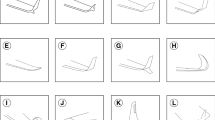Abstract
In this research, the effects of propeller slipstream on wing boundary layer and transition front were studied through wind tunnel tests and numerical analysis. In this respect, the flow around a NACA 6-series airfoil section was simulated in a computational fluid dynamics solver without and with propeller flowfield. The numerical study, presented in this paper, was concerned with the effect of propeller slipstream on both wing aerodynamics and boundary layer treatment. For experimental tests, oil flow visualization technique was used to determine laminar to turbulent transition location, laminar separation bubble with turbulent reattachment and turbulent separation line over the wing surfaces. Existence of propeller slipstream changed pressure and skin friction distribution over the wing surfaces, in both chordwise and spanwise directions and it hence affected on the wing loading distribution. Also upstream propeller affected on boundary layer characteristics including laminar/turbulent transition onset and separation over the wing. The results showed that the transition location moved toward the leading edge, and the separation bubble was washed out due to propeller slipstream.
Graphical abstract


















Similar content being viewed by others
Abbreviations
- CFD:
-
Computational fluid dynamics
- RPM:
-
Revolution per minute
- TI:
-
Turbulence intensity
- b :
-
Wing span
- c :
-
Chord length
- C f :
-
Skin friction coefficient
- C L :
-
Lift coefficient
- C p :
-
Pressure coefficient
- D :
-
Propeller diameter
- J :
-
Advanced ratio
- N :
-
Rotational speed
- Re :
-
Reynolds number
- S :
-
Strain rate
- t :
-
Time
- U :
-
Local velocity
- V :
-
Free stream velocity
- x :
-
Chordwise direction
- y :
-
Spanwise direction
- z :
-
Vertical direction
- α :
-
Incidence angle
- γ :
-
Intermittency coefficient
- θ :
-
Momentum thickness
- μ :
-
Molecular viscosity
- μ t :
-
Eddy viscosity
- ρ :
-
Density
- Ω :
-
Vorticity
References
Aminaei H, Dehghan Manshadi M, Mostofizadeh AR (2017) Numerical estimation of the wing boundary layer transition in propeller flowfield. Modares Mech Eng 17(2):157–165 (in Persian)
Aminaei H, Dehghan Manshadi M, Mostofizadeh AR (2018) Experimental investigation of propeller slipstream effects on the wing aerodynamics and boundary layer treatment at low Reynolds number. Proc Inst Mech Eng Part G J Aerosp Eng. https://doi.org/10.1177/0954410018793703
Barlow JB, Rae WH, Pope A (1999) Low speed wind tunnel testing, 3rd edn. Wiley, New York
Catalano FM (2004) On the effects of an installed propeller slipstream on wing aerodynamic characteristics. Acta Polytech 44(3):1–8
Dehghan Manshadi M, Hejranfar K, Farajollahi AH (2017) Effect of vortex generators on hydrodynamic behavior of an underwater axisymmetric hull at high angles of attack. J Vis. https://doi.org/10.1007/s12650-016-0412-4
Elsaadawy EA, Britcher CP (2000) Experimental investigation of the effect of propeller slipstream on boundary layer behavior at low Reynolds number. In: 18th Applied aerodynamics conference, Denver, CO, USA, pp 267–276
Fratello G, Favier D, Maresca C (1991) Experimental and numerical study of the propeller/fixed wing interaction. J Aircr 28(6):365–373
Fu W, Li J, Wang H (2012) Numerical simulation of propeller slipstream effect on a propeller-driven unmanned aerial vehicle. In: International conference on advances in computational modeling and simulation. Elsevier, pp 150–155
Fürst J, Straka P, Příhoda J, Šimurda D (2012) Comparison of several models of the laminar/turbulent transition. In: 7th International experimental fluid mechanics conference, Hradec Králové, Czech Republic, 20–23 November
Menter FR, Langtry RB, Likki SR, Suzen YB, Huang PG, Völker S (2006) A correlation-based transition model using local variables-part I: model formulation. J Turbomach 128(3):413–422
Menter FR, Smirnov PE, Liu T, Avancha R (2015) A one-equation local correlation-based transition model. Flow Turbul Combust 95(4):583–619
O’Meara MM, Mueller TJ (1986) Experimental determination of the laminar separation bubble characteristics of an airfoil at low Reynolds numbers. In: AIAA/ASME 4th fluid mechanics, plasma dynamics and lasers conference, 12–14 May, Atlanta
Reed HL, Saric WS (1989) Stability of three-dimensional boundary layers. Ann Rev Fluid Mech 21:235–284
Schroijen MJT, Veldhuis LLM, Slingerland R (2008) Propeller slipstream investigation using the Fokker F27 wind tunnel model with flaps deflected. In: 26th International congress of the aeronautical science, ICAS
Schroijen MJT, Veldhuis LLM, Slingerland R (2010) Propeller empennage interaction effects on vertical tail design of multiengine aircraft. J Aircr 47(4):1133–1140
Silisteanu PD, Botez RM (2010) Transition-flow-occurrence estimation: a new method. J Aircr 47(2):703–707
Sohankar A, Mohagheghian S, Dehghan AA, Dehghan Manshadi M (2015) A smoke visualization study of the flow over a square cylinder at incidence and tandem square cylinders. J Vis. https://doi.org/10.1007/s12650-015-0275-0
Tyagi H, Liu R, Ting DSK, Johnston CR (2006) Measurement of wake properties of a sphere in free stream turbulence. Exp Therm Fluid Sci 30:587–604
Veldhuis LLM (2005) Propeller wing aerodynamic interference. Dissertation, Delft University of Technology, The Netherlands
White F (2006) Viscous fluid flow, 3rd edn. McGraw Hill, New York
Author information
Authors and Affiliations
Corresponding author
Additional information
Publisher's Note
Springer Nature remains neutral with regard to jurisdictional claims in published maps and institutional affiliations.
Rights and permissions
About this article
Cite this article
Aminaei, H., Mostofizadeh, A.R. & Dehghan Manshadi, M. Experimental and numerical study of wing boundary layer behavior in propeller flowfield. J Vis 22, 489–503 (2019). https://doi.org/10.1007/s12650-019-00553-w
Received:
Revised:
Accepted:
Published:
Issue Date:
DOI: https://doi.org/10.1007/s12650-019-00553-w




